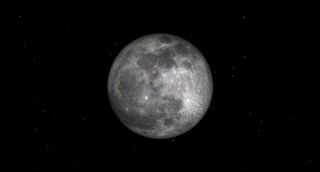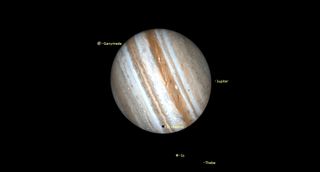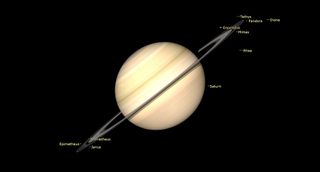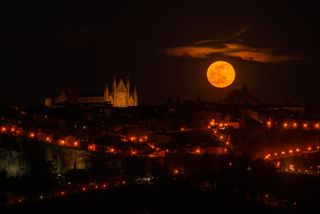April full moon 2024: The Pink Moon joins Mars and Saturn in the night sky
The full moon of April 2024, called the Pink Moon, will occur during the evening hours of April 23. Later that night, Mars and Saturn will rise in the predawn hours.

The full moon of April, called the Pink Moon, will occur in the eastern U.S. during the evening hours of April 23, at 7:49 p.m. Eastern Daylight Time (2349 UT). Later that night, Mars and Saturn will rise in the predawn hours.
Full moons occur when the moon is exactly on the opposite side of Earth from the Sun. The phase of the moon is determined by its position relative to Earth, rather than one's position on Earth's surface, so the timing depends on one's time zone. Observers in London would see the moon reach full phase at 11:49 p.m. local time; in Chicago it would be at 6:49 p.m. local time.
Observing from New York City, the moon will rise at 7:43 p.m. local time, according to the U.S. Naval Observatory. Sunset that day is at 7:44 p.m. The moon will be in the constellation Virgo. If one is observing from Miami, moonrise is at 7:46 p.m. local time and the sun sets at 7:48 p.m. In Rio de Janeiro, where the full moon is at 8:48 p.m. local time, moonrise is at 5:18 p.m.; sunset is at 5:32 p.m.
Related: Full moon calendar 2023: When to see the next full moon
As one moves eastwards, the moment of the full moon occurs later in the evening – as one reaches eastern Europe the full phase moves into the morning hours of April 24; for example, in Paris, the moon rises at 8:41 p.m. local time on April 23 and reaches full phase at 1:48 a.m. In Delhi, the moon reaches full phase at 5:18 a.m. and sets soon afterwards at 5:44 a.m. Much further east than that and the moon is below the horizon when it becomes officially full.

Looking for a telescope to observe the features of the full moon up close? We recommend the Celestron Astro Fi 102 as the top pick in our best beginner's telescope guide. Don't forget a moon filter!
The full moon is the second brightest object in the sky after the sun, and binoculars or a small telescope can make it appear so bright that seeing details is difficult; there are no shadows to give any contrast or define shapes. If one were standing on the moon, the sun (and Earth) would be directly overhead. (In fact one would see the Earth's night side slightly illuminated by the light reflected from the moon). If one waits a few days after the full moon or observes a few days before, shadows bring out more detail.
Hoping to snap a good photo of this full moon? Our guide on how to photograph the moon has some helpful tips. If you're looking for a camera, here's our overview on the best cameras for astrophotography and best lenses for astrophotography. As always, our guides for the best telescopes and best binoculars can help you prepare for the next great skywatching event.
Get the Space.com Newsletter
Breaking space news, the latest updates on rocket launches, skywatching events and more!
Read more: How to observe the moon with a telescope
April's Full Pink Moon and visible planets
On the evening of April 23, Jupiter will, for observers in mid-northern latitudes, be low in the west; in New York the planet sets at about 9:14 p.m. local time, about an hour and a half after sunset. At sunset Jupiter is only about 15 degrees above the horizon, so even though it is one of the first "stars" to appear as the sky gets dark, it will be a challenge to spot it unless one has a flat horizon and very clear sky. By about 8:15 p.m. it is only about 10 degrees high, though by that time the sky will be dark enough for other bright stars to be seen as well.
The other naked-eye planets will all be seen in the predawn sky. In New York (and at similar latitudes) Saturn rises at 4:17 a.m. on April 24 and Mars follows at 4:36 a.m. Sunrise in New York is at 6:03 a.m. Eastern Time, so both planets will be quite low in the east; by 5 a.m. Saturn, the higher of the two, will be only about 8 degrees above the horizon and Mars will be only at 5 degrees. To find them, look due east for Mars, which has a distinct reddish hue, and look upwards and to the right of it to see Saturn.
From mid-northern latitudes Venus and Mercury both rise so close to the sun that they are nearly impossible to spot; Mercury, for example, rises April 24 5:24 a.m. local time in New York, and is so close to the horizon that it is only 6 degrees high at sunrise; Venus is only 3 degrees high at that point. Both will be largely lost in the solar glare.

As one moves southwards the situation for spotting planets improves. In Miami, for example, sunset on April 23 is at 7:48 p.m. local time and civil twilight, when the sun reaches 6 degrees below the horizon and the sky starts to darken, is at 8:12 p.m.
At sunset Jupiter is 16 degrees high, and by 8:15 it is at 11 degrees, about two lunar diameters higher than in New York City. In San Juan, Puerto Rico, Jupiter sets at 8:03 p.m. local time; sunset is at 6:44 p.m. Atlantic Standard Time (Puerto Rico does not observe daylight savings) and Jupiter is 17 degrees above the horizon at that point and about 12 degrees high as the sky gets dark by about 7 p.m.
From cities near the Equator such as Quito or Singapore, Jupiter is similarly high; in Quito the sun sets at 6:15 p.m. and Jupiter at 7:28 p.m. local time, and at sunset Jupiter is still about 16 degrees above the western horizon. As one gets into the Southern Hemisphere, Jupiter starts to once again appear lower in the sky; in Buenos Aires the planet is only 10 degrees above the northwestern horizon at sunset, which is at 6:19 p.m. on April 23.

For the pre-dawn planets, as with Jupiter, the observing is better the closer to the Equator one gets. In Miami, for example, where sunrise on April 24 is at 6:49 a.m., Saturn rises at 4:32 a.m. and Mars follows at 4:57 a.m. Civil twilight, when the sun is 6 degrees below the horizon and the sky is getting light, is at 6:25 a.m.
At that point Saturn is 24 degrees high in the east-southeast, Mars is below it and to the left at about 19 degrees. Mercury, which from further north is lost in the solar glare, is barely visible at about 6 degrees high; seeing it still requires a lot of luck and very clear sky conditions. The innermost planet rises at 5:57 a.m.
From San Juan, Saturn rises at 3:31 a.m., and Mars at 3:49 a.m. local time. Sunrise is at 6:01 a.m. and Saturn reaches a full 31 degrees in altitude by then; a half hour before sunrise it is at 27 degrees and Mars is at 21 degrees. Mercury is also higher than in New York City or Miami; by 5:30 a.m. local time the planet is already about 6 degrees high and by sunrise it is at 13 degrees. It's still a challenge to track down, but somewhat less so than further north.
In Quito, where sunrise is at 6:04 a.m. local time on April 24, Saturn rises at 3:11 a.m. – nearly three hours before the sun – and by 5:47 a.m., when civil twilight begins, the ringed planet is 34 degrees high in the east. Mars will be below it and slightly to the left (northwards) at 30 degrees high; the red planet rises there at 3:44 a.m. And Mercury, which is so elusive for Northern Hemisphere skywatchers, rises at 5:01 a.m. and reaches 11 degrees high and is almost due east, making it a much more realistic naked-eye target; the planet will poke above the horizon while the sky is still dark.
In the Southern Hemisphere, observers in Buenos Aires will see Saturn rise at 3:30 a.m., Mars at 4:15 a.m., Mercury at 5:54 a.m., and Venus at 6:31 a.m. local time. Sunrise is at 7:24 a.m. on April 24, so by civil twilight's end at 6:58 a.m. it's even possible to see Venus, which will be 5 degrees high in the east. If conditions are right one will be able to see a line of planets starting with Saturn at the top (it will be some 41 degrees high just north of east), Mars below and to the right (slightly south of it) at 32 degrees, and then Mercury at 12 degrees and slightly south of that, with Venus at the bottom.

Constellations with the Full Pink Moon
In the late April sky, for Northern Hemisphere observers the bright winter constellations of Orion, Taurus, Gemini, and Canis Major are all setting by the time it is completely dark – at 9 p.m. Orion's feet are touching the western horizon. Looking north, find the Big Dipper, which will be nearly overhead, as though it were pouring its contents towards the northern horizon. Using the famous "pointers" – the two stars at the front of the bowl, Dubhe and Merak, one can find Polaris, the North Star.
Going in the other direction – southwards – the pointers take you to a right triangle of stars that is the hindquarters of Leo the Lion. The right triangle points west, and the westernmost (and brightest) star is the end of the Lion's tail, called Denebola. From Denebola one can make a straight horizontal line going to the right (if you are facing south) that reaches Regulus, the brightest star in Leo.

As the full moon will be rising in the east, one can see around it two bright stars. The one above and to the right of the moon is Spica, the brightest star in Virgo, and to the left and higher (draw a line at about a 45 degree angle) one will see Arcturus, the brightest star in Boötes, the Herdsman.
In the Southern Hemisphere the sky is "upside down" so by about 9 p.m. at the latitudes of Buenos Aires Spica will appear above and to the left of the moon, and Arcturus will be below the moon, and to the left, closer to the horizon. Antares, the heart of Scorpius, the Scorpion, will be just rising in the southeast. Looking upwards in the southeast one will see Rigil Kentaurus and Hadar, the former being closer to the horizon, and just above those the Southern Cross. Canopus, the alpha star of Carina, the Ship's Keel, will be high in the southwest.
April full moon lore
According to The Old Farmer's Almanac calls the April full moon the Pink Moon, but that hasn't much to do with the color of the moon itself. The name "Pink Moon" comes from the bloom of ground phlox, a pink flower common in North America. Other names include the Sprouting Grass Moon, Egg Moon and Fish Moon.
The the Ontario Native Literacy Coalition notes that the Ojibwe people called it the Sucker Moon after the common fish species known as suckerfish or remora. The Ojibwe saw the fish as a messenger between the spirit world and ours. In the same region, the Cree called April's full moon the Goose Moon, marking the month when geese returned to the north after migrating south for the winter.
For Jewish people the April full moon falls in the month of Nisan, on the lunar Hebrew calendar. The Passover holiday starts at sunset on April 22. Most of the time Passover and Easter coincide, but this year they do not; the reason is that Christian calendars use the spring equinox (usually around March 21) as a base to calculate the date of Easter from the first full moon after the equinox; in this case that happened on March 25, and the first Sunday after that was March 31. The Hebrew calendar ignores that and puts Passover in the corresponding lunar month, which can shift several weeks away from the equinox.

Lunar calendars exist in many other traditions; in the Southern Hemisphere the Zulu called the April lunation uMbasa, and the Māori of New Zealand called the April moon "Paenga-whāwhā," and described the period as when "all straw is now stacked at the borders of the plantations," according to The Encyclopedia of New Zealand.
In China the April lunation corresponds with the third month of the year, called Táoyuè (桃月) or Peach month. The Bai people in Yunnan province celebrate the Third Month Fair from the 15th to the 30th day of the lunar month.
Editor's note: If you get an amazing photo of April's Full Pink Moon you'd like to share for a possible story or image gallery, you can send images and comments in to spacephotos@futurenet.com.
Join our Space Forums to keep talking space on the latest missions, night sky and more! And if you have a news tip, correction or comment, let us know at: community@space.com.

Jesse Emspak is a freelance journalist who has contributed to several publications, including Space.com, Scientific American, New Scientist, Smithsonian.com and Undark. He focuses on physics and cool technologies but has been known to write about the odder stories of human health and science as it relates to culture. Jesse has a Master of Arts from the University of California, Berkeley School of Journalism, and a Bachelor of Arts from the University of Rochester. Jesse spent years covering finance and cut his teeth at local newspapers, working local politics and police beats. Jesse likes to stay active and holds a fourth degree black belt in Karate, which just means he now knows how much he has to learn and the importance of good teaching.
